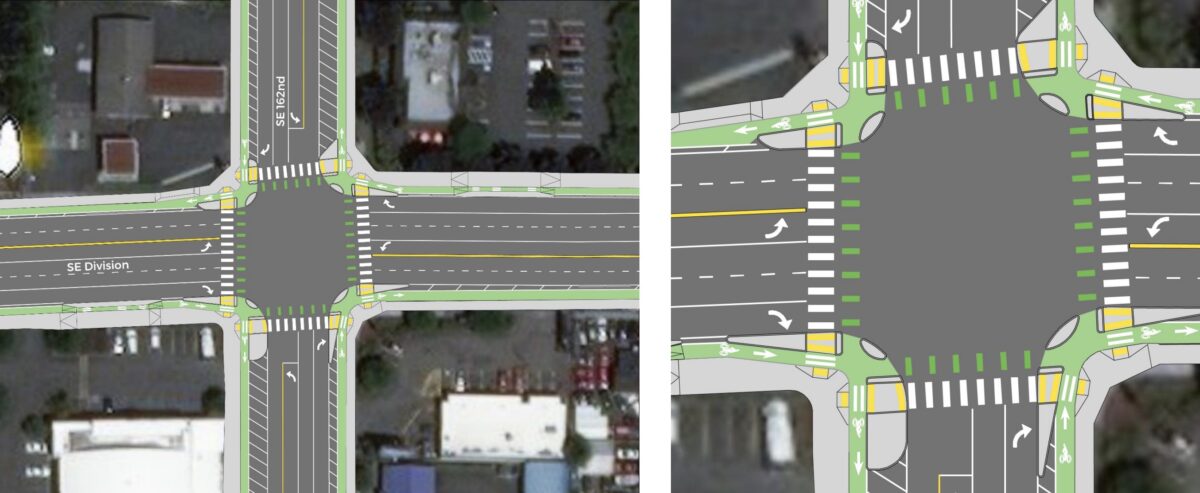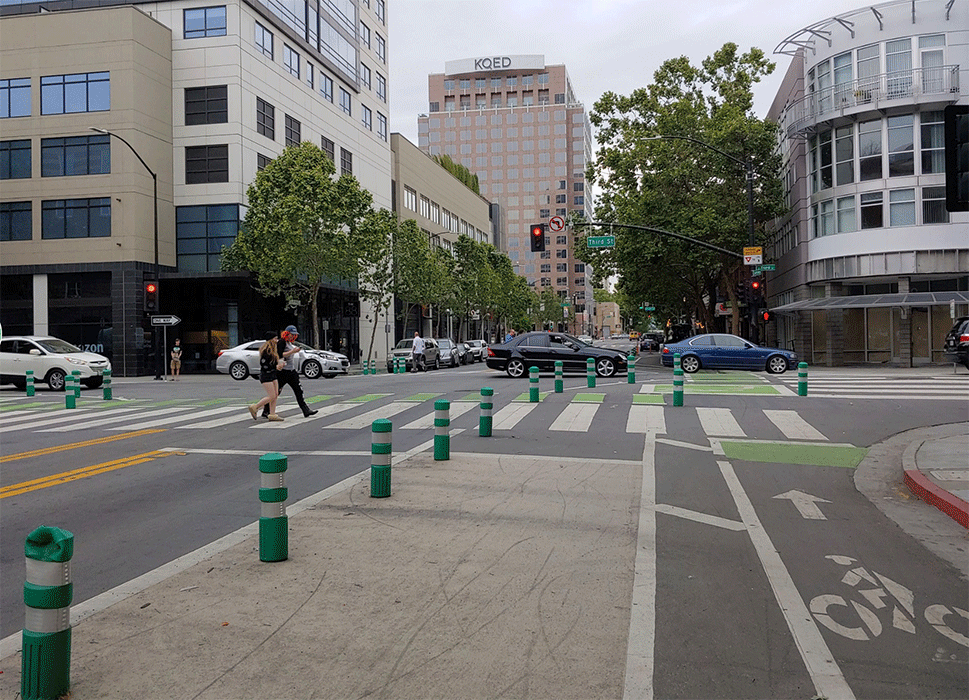
Staff working on TriMet’s Division Transit Project dropped a bit of a bombshell at the end of an advisory committee meeting earlier this week: They plan to build protected intersections at SE 122nd, 148th, and 162nd.
Protected intersections are a big deal. They are considered the safest way to handle bicycle traffic at what’s typically considered the weakest link in a safe facility. According to the National Highway Traffic Safety Administration, 43% of urban cycling fatalities occur at intersections.
“This design can reduce the likelihood of high-speed vehicle turns, improve sight lines, and dramatically reduce the distance and time during which people on bikes are exposed to conflicts.”
— National Association of City Transportation Officials (NACTO) on protected intersections
TriMet has spent five years planning the $175 million Division Transit Project and is now just six months away from the start of construction. The main goal is to speed up and boost capacity of buses to help more people reap the benefits of reliable, affordable, carfree transportation. TriMet says the 15 miles of “enhanced service” between downtown Portland and Gresham will speed up travel times an average of 15-20%.
We’ve recently focused on how bicycle users would interact with the new station designs; but we hadn’t heard anything about protected intersections until Tuesday night.
The plans were shared during a presentation (PDF) to the joint meeting of the Portland Bureau of Transportation’s bicycle and pedestrian advisory committees. TriMet says the designs are still in development and they’re working with PBOT to further vet them and make changes if necessary.
Protected intersections were first fleshed out by Portland planner Nick Falbo (who now works for PBOT) in 2014. Since then, over a dozen U.S. have installed them; but Portland hasn’t. We hoped to see one on the West Burnside project (currently under construction), but because of the off-set nature of the intersection and other compromises made during the design process, it’s not a perfect example.
Advertisement
 (Before-and-after of a protected intersection in San Jose, CA. GIF made from images taken from NACTO website).
(Before-and-after of a protected intersection in San Jose, CA. GIF made from images taken from NACTO website).
In their just-released design guide, the National Association of City Transportation Officials (NACTO) writes that protected intersections are, “Physically separated crossings that provide a high degree of comfort and safety for people of all ages and abilities. This design can reduce the likelihood of high-speed vehicle turns, improve sight lines, and dramatically reduce the distance and time during which people on bikes are exposed to conflicts.”
TriMet Project Manager Jesse Stemmler told us they intend to use the treatment on Division because the typical way to handle left turns for bicycle riders — a “two-stage turn” with green queue boxes — won’t work given the traffic volumes and other operational issues at these intersections. “We instead needed to create a protected space that would still allow for right turns and bus through movement, while allowing for refuge space for people bicycling and walking, with signal phasing protection from right turning traffic (no right turn on red) for both.”
Here’s more from TriMet on their rationale for the design:
The protected intersection design would narrow roadway crossing distances and exposure time for people walking, and provide physical protection between the bike lane and the intersection. It would provide space for left-turning bicycles to queue outside of the motor vehicle travel lanes while making a two-stage turn. This will allow the signal to be operated with concurrent left and right turn phasing for motor vehicles, which will reduce delay for buses on Division by keeping them in the travel lane and allowing for queue jumps.
This would be a huge upgrade to these intersections. Let’s hope (and do what we can to make sure) they don’t get value-engineered or compromised out of the project.
Construction of the Division Transit Project is expected to start in November with service to begin in 2022. Learn more in our archives or at TriMet.org/Division
— Jonathan Maus: (503) 706-8804, @jonathan_maus on Twitter and jonathan@bikeportland.org
Never miss a story. Sign-up for the daily BP Headlines email.
BikePortland needs your support.

